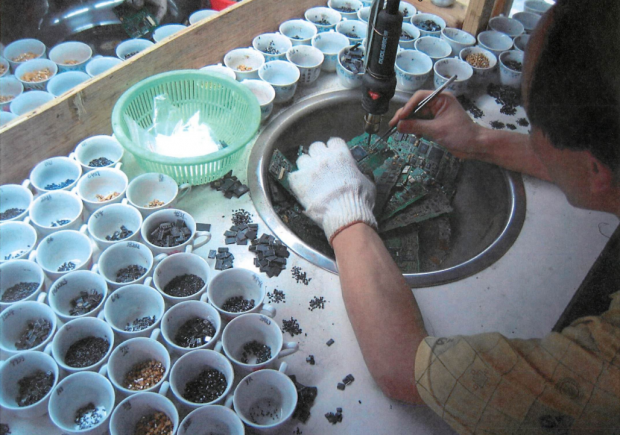We interviewed Jack Wolosewicz, CTO of Eurocal Group (a New Tech Press sponsor) recently about the recurring stories regarding Android security.
Hacking by sound not that simple
A recent story from Reuters kicked up a bit of a stir by claiming that hackers could use sound to steal data from a computer or network. While the story was true it turns out that it isn't the whole story and is less of a problem than the report inferred, according to cybersecurity expert Jack Wolosewicz. Here's the interview.
OpenText offers secure collaboration environment
At the 52nd Design Automation Conference in San Francisco, we talked to Rod Simon of OpenText about their collaboration platform, Exceed VA Turbo X that was introduced to the EDA industry at the conference. With a web-based interface, Exceed VA TurboX is a hybrid solution intended to improve users productivity by enhancing collaboration from any location, securely. Exceed VA TurboX is designed for the enterprise data center so administrators to easily manage and monitor access to sensitive applications and data. Here's the interview:
#EELive Keynote sees bright side of death of Moore's Law
The death of Moore's Law, predicted annually for the past decade, may not be as bad for the electronics industry, as opposed to what some hand-wringers have expected. Unless you work for Intel, that is. In fact, it might unleash a new wave of innovation driven by user expectation rather than an engineers’ linear imagination.

That was the core of the keynote delivered today at EELive in San Jose by Bunnie Huang, MIT EE PhD. and renowned hardware hacker.
Huang pointed out that Moore's Law has been very good for Big Silicon over the past several decades with the x86 architecture scuttling every attempt to supplant its supremacy (anyone remember the Alpha chip?). And while that has been very good for Intel and its customers, it has also buried real innovation based on end-user needs.
But as the physical limitations of silicon have put up very real barriers to the continuation of the Moore paradigm, the opportunity for that innovation has opened wide, Huang said.

At the basis of this "revolution" is the reality that a six- to eight-year development cycle for new products is no longer that unrealistic, now that hardware performance upgrades won’t be happening every 18 months, as per Moore. The performance upgrades are now coming from hardware and software optimization on competing platforms like ARM and Imagination Technologies cores.
"It wasn't too long ago that an ARM-based processor was the basis for toasters and DVD players. Today those cores are viable options for servers and 64-bit cores are not that far away," Huang predicted.
But even more important is the trend to recycling components and the easily obtainable how-to manuals available from China, where, Huang said, a growing industry makes it possible to build your own devices running on open source software. There is a glut of electronic devices and systems in the world that contain perfectly sound components that can be harvested and sold for pennies on the dollar against new components. That same industry is producing manuals for the component buyers guiding them though the build. Those same components can be used to repair existing products.
Yes, that may violate Western patent laws, but the reality is, the cows are out of the barn and it is extremely difficult to put them back in now. Component harvesting is beginning in the west for engineers who want to build their own prototypes and can't get the attention of major component manufacturers because they are too small to be taken seriously as customers. Since these innovators are no longer handcuffed to Moore's Law advances, they can take their time and actually consider user needs and produce beta products before ever making the "big buy" from major suppliers.
The availability of inexpensive components, reliable documentation and open-source software, according to Huang, mean it may be possible, within a decade, to see the availability of low-cost and open-source hardware for general consumer purchase.
Backfitting security into legacy embedded systems
Icon Labs announced the Floodgate Defender Appliance earlier this year as a means to backfit security into legacy embedded systems and we sat down with the company's CEO, Alan Grau to talk about just how crucial this is. The video follows:
Cool stuff you might have missed at Design West, 2013
By Lou CoveyEditorial Director
Every year I go to Design West in San Jose to look for the cool geeky products and displays that you aren't "officially" supposed to be there to check out, because you're supposed to be doing work related research. This year, it was either a little tougher to find this information or their just wasn't as much, but I found three off-the-beaten track exhibits that you might have missed. They included an android-based streaming media device that could be used to bypass the movie service in hotels; a device that you can use as a low-cost, DIY car locator (take that Lo Jack); and an honest-to-gosh Enigma Machine from World War II. Check it out.
[subscribe2]
Connect Tech's Qseven at core of military VR system
Connect Tech, based in Ontario, Canada, designs and manufactures serial communication hardware and software for a range of industries, including communications, industrial automation, transportation, government, military, scientific, medical, educational, POS, and office automation. At DesignWest, they exhibited a military training system from Quantum3D, that was driven by custom single-board computer, built on Connect Tech's Qseven Carrier board with an Intel® Atom™ processor. New Tech Press dropped by and had a bit of fun with the team.
Learn more at element14.com
Teen robotics team learns realities of high-tech product development
By Lou CoveyNew Tech Press Editorial Director
The FIRST national robotics championship brings together teams from high schools and high school districts from all over the US to solve a particular set of challenges every year. At this year's competition in St. Louis, Missouri, the week of April 23, the teams will work cooperatively in a series of 3-on-3 basketball games using homegrown robots, mostly student designed.
One of the veteran groups, Team 100 from the Sequoia Union High School District in San Mateo County, California is going to the competition as a "wild card" participant. The team has had a long experience in the competition going back to 1995 (national champion.) In the path toward their current creation, the team found that what the basic design provided was not sufficient for the task.
Woodside High School junior Andrew Blatner, part of the electronics engineering crew for Team 100, said the standard CAN bus (controller area network) that the teams use in their projects was insufficient to deal with the communication between motor controllers. The team attempted to use a workaround that converted the ethernet signals. "That still didn't solve all the problems we were having in competition so we switched to direct communication to individual controllers."
Team advisor Laura Rhodes said another problem was a limitation on the number of inputs the project needed, so one of the team members, Ethan Anderson, Woodside High School senior, brought up the idea of using an Arduino development board to expand the available number of inputs. Anderson had some experience using Arduino in personal home projects and several advisors had additional input based on their experience.
A remarkable aspect of the project is how it mirrored problem solving efforts experienced by professional product development teams, as in the software phase of the project. Connor Wake, Sequoia High School senior and part of the software sub-team, said several new aspects of the competition created unique software control issues. The team decided early on to switch from National Instruments Labview to Wind River C++ to handle the use of cameras, motor controls for shooting the ball at different angles and speeds and to control intakes to avoid jamming. New team members had to be trained in the use of the tools and legacy code integrated.
What was unusual in the project development was the lack of "walls" between the sub teams. Wake spoke in detail of the various mechanical aspects of the robot, and Anderson demonstrated more than a working knowledge of the software difficulties.
Rhodes said the goals of Team 100 students have always been to acquire real–life skills and gain hands-on engineering experience. Originally, the team consisted of solely of Woodside High School students, but in 2003, a large group of students from Carlmont High School, a neighboring district school, joined the team, soon becoming a permanent addition. During recent seasons, Sequoia High School students have also been added to the roster, creating the current tri-school team. The team's primary sponsor is DreamWorks P.D.I.
Tying the home to the Smart Grid
Most of the attention in the Smart Grid is given to the utilities and their controversial wireless smart meters. But for the consumer to see real value in the technology requires creating a local network of appliances and systems within the home. That's not an easy task. There are many smart appliances on the market ready to tie into the grid, but not everyone is flush enough to go out an buy an entirely new set of appliances. Somehow, the industry needs to create aftermarket. At the DesignWest conference, Qualcomm Atheros was demonstrating your their products and techniques can move you closer to energy efficiency, if not complete independence. New Tech Press interviewed Qualcomm Atheros product manager Tim Colleran on what's happening.
Nabto offers development help for their worldwide firewall
Security in the "Internet of Things" is becoming a major issue in embedded, portable device industry and the tiny Danish company of Nabto is helping customers take a step toward securing new devices. At DesignWest, Nabto was talking about the Nabduino, a Arduino-based development board with their tiny (less than one meg) webserver IP that can place your device behind the corporate firewall...anywhere in the world. New Tech Press dropped by to chat with them.
Screaming Circuits finds silver lining in economic downturn
The economic downturn has had an upside for some industry segments. PCB prototyping service Screaming Circuits has seen business climb steadily since it's founding in 2003 as more companies have cut back staff and resources, stretching engineering staffs beyond their own capabilities. Screaming Circuits recently formed a relationship with Newark/element14 to offer their services to the element14 community. In this interview with Duane Benson, director of marketing and sales, Benson elaborates on the growing prototyping market in the PCB industry as well as the challenges and needs of their customer base.

